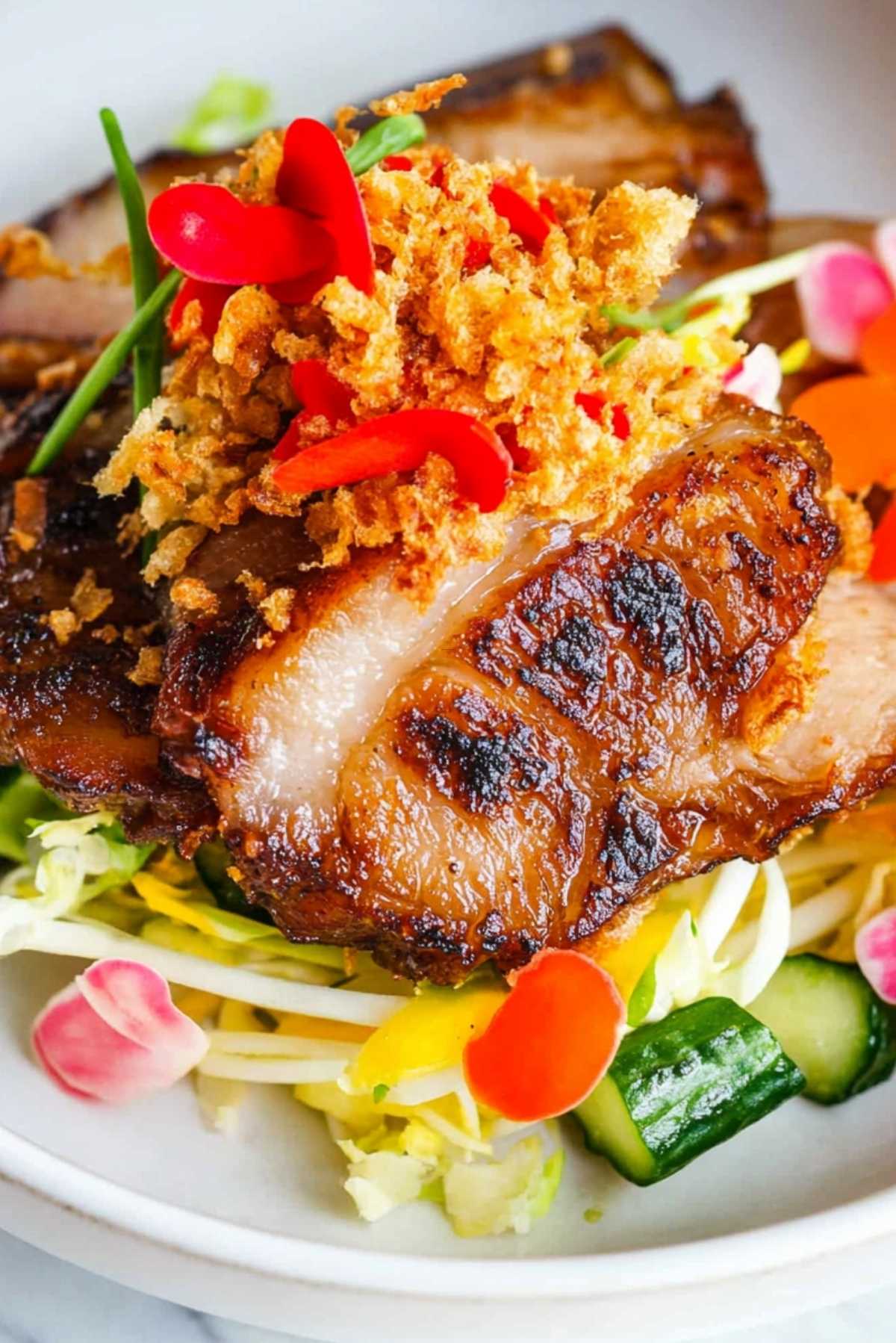If you’re craving something rich, savory, and fresh, this Korean Pork Belly with Sumi Salad is the perfect balance of flavors and textures. The crispy, juicy pork belly pairs beautifully with a crunchy, tangy Sumi salad, creating a dish that’s not only satisfying but also incredibly exciting for your taste buds. This dish combines the deep flavors of Korean cuisine with the light, fresh qualities of a salad—making it a feast for both your stomach and your senses.
Why You’ll Love This Recipe?
This Korean Pork Belly with Sumi Salad is the best of both worlds: indulgent yet refreshing. The pork belly is cooked to crispy perfection, bringing all those savory, umami-packed flavors to the table. And when paired with the vibrant, crunchy Sumi salad, you get a fresh contrast that balances the richness of the pork. The dish is versatile enough for a weeknight dinner or a special occasion. Plus, the tangy-sweet dressing on the salad adds just the right kick to tie everything together.
Ingredients
For the Korean Pork Belly:
- 500g pork belly, skin-on, cut into 1-inch pieces
- 1 tablespoon vegetable oil
- 2 tablespoons soy sauce
- 1 tablespoon sesame oil
- 1 tablespoon rice vinegar
- 1 tablespoon brown sugar
- 1 tablespoon garlic, minced
- 1 tablespoon ginger, minced
- 1 teaspoon gochugaru (Korean chili flakes) or gochujang (Korean chili paste) for heat (optional)
- 1/2 teaspoon black pepper
- 1/2 teaspoon salt
- 1 teaspoon sesame seeds (for garnish)
- 1 tablespoon chopped green onions (for garnish)
For the Sumi Salad:
- 1 small cucumber, julienned
- 1 carrot, julienned
- 1/2 red bell pepper, thinly sliced
- 1/2 yellow bell pepper, thinly sliced
- 1/4 small red onion, thinly sliced
- 1 handful cilantro, chopped
- 1 handful mint, chopped
- 1 tablespoon sesame oil
- 1 tablespoon rice vinegar
- 1 teaspoon soy sauce
- 1 teaspoon honey
- 1/4 teaspoon salt
- 1/4 teaspoon black pepper
- 1 tablespoon sesame seeds (for garnish)
You can find the full list of ingredients below.
Directions
1. Prepare the Pork Belly
Start by prepping the pork belly. Pat the pieces dry with paper towels, which will help them crisp up during cooking. Season the pork belly with a pinch of salt and black pepper. Heat vegetable oil in a large skillet or cast-iron pan over medium-high heat. Once the pan is hot, add the pork belly and sear it on all sides until it becomes golden brown and crispy, about 8-10 minutes.
2. Make the Marinade and Glaze
While the pork is cooking, whisk together soy sauce, sesame oil, rice vinegar, brown sugar, minced garlic, and ginger in a small bowl. If you want a little spice, add gochugaru or gochujang to the mixture. Once the pork belly is browned and crispy, pour the marinade over the pork and cook for an additional 2-3 minutes, allowing the sauce to thicken slightly and coat the pork. Be sure to flip the pieces of pork so they’re evenly glazed.
3. Prepare the Sumi Salad
While the pork belly is cooking, prepare the salad. In a large mixing bowl, combine the julienned cucumber, carrot, red and yellow bell peppers, and red onion. Add the chopped cilantro and mint for extra freshness. In a small bowl, whisk together sesame oil, rice vinegar, soy sauce, honey, salt, and pepper to create the dressing.
4. Toss the Salad
Pour the dressing over the vegetables and toss everything gently, ensuring the salad is evenly coated with the dressing. You want the vegetables to stay crisp and fresh, so be gentle with the tossing.
5. Serve the Dish
To serve, arrange a generous portion of the Sumi salad on a plate or platter. Top with the crispy Korean pork belly and drizzle any extra glaze from the pan over the pork. Garnish with sesame seeds and chopped green onions for an added touch of flavor and texture.
Expert Tips and Tricks
- Crisp Pork Belly: For extra crispy pork belly, make sure the pieces are dry before searing, and don’t overcrowd the pan. This allows each piece to get golden and crispy.
- Make Ahead: You can marinate the pork belly a few hours in advance, or even overnight, for more depth of flavor. Just make sure to cook it fresh to retain that crispy texture.
- Adjust the Spice: If you prefer your dish spicier, increase the amount of gochugaru or add a bit more gochujang to the glaze. You can also sprinkle some chili flakes on the finished dish.
- Substitute Veggies: If you can’t find some of the veggies for the salad, feel free to substitute with whatever you have—shredded cabbage or even thinly sliced zucchini would work well.
Recipe Variations and Possible Substitutions
- Pork Substitution: If you’re not a fan of pork belly, you can easily substitute with boneless chicken thighs or beef short ribs. Both will take on the marinade and glaze beautifully.
- For a lighter salad: You can skip the sesame oil and use olive oil in the salad dressing for a lighter version, though the sesame oil adds a nice nutty flavor that complements the pork.
- Add Some Crunch: If you like extra texture, consider adding some toasted peanuts or cashews to the salad for a bit of crunch.
- Vegan Version: To make this dish vegan, substitute the pork belly with crispy tofu or tempeh. Use a plant-based honey alternative or maple syrup in the dressing.
Serving and Pairing Suggestions
This Korean Pork Belly with Sumi Salad is a fantastic standalone dish, but it also pairs well with steamed rice or a side of kimchi to round out the meal. If you’re looking for something more substantial, serve it alongside a warm bowl of miso soup or some crispy Korean pancakes (pajeon).
Storage and Reheating Tips
While the pork belly will keep its flavor well, it’s best enjoyed fresh for that crispy texture. If you have leftovers, store the pork belly separately from the salad. The pork belly can be kept in an airtight container in the fridge for up to 2 days, but the salad is best eaten the day it’s made. To reheat the pork belly, simply crisp it up in a hot pan for a few minutes.
4 FAQs
1. Can I use a different cut of pork?
If you can’t find pork belly, you can substitute with pork shoulder or even pork tenderloin. Just make sure to adjust the cooking time, as these cuts may cook faster or differently than belly.
2. Can I make the salad in advance?
You can prep the veggies for the salad ahead of time, but it’s best to dress the salad just before serving to keep the vegetables crunchy.
3. Can I add more vegetables to the salad?
Absolutely! Feel free to add more veggies like radishes, bean sprouts, or even shredded cabbage. The dressing complements many types of fresh, crunchy vegetables.
4. Can I make this dish spicy?
Yes! If you enjoy a little heat, you can increase the amount of gochugaru or add a spoonful of gochujang to the glaze. You can also sprinkle extra chili flakes on top for more heat.
Conclusion
Korean Pork Belly with Sumi Salad is a dish that offers an incredible balance of flavors—rich, savory, and crispy pork belly alongside a fresh, crunchy, and tangy salad. Whether you’re serving it for dinner or a special occasion, it’s a crowd-pleaser that brings the best of Korean flavors and vibrant freshness to your plate. This recipe is sure to become a favorite in your kitchen—give it a try, and enjoy the perfect fusion of comfort and freshness!
Print
Korean Pork Belly with Sumi Salad
- Prep Time: 15 minutes
- Cook Time: 15-20 minutes
- Total Time: 30-35 minutes
- Yield: 4 servings 1x
- Category: Main Course
- Method: Pan-frying
- Cuisine: Korean
Description
A delicious fusion of crispy, juicy Korean pork belly paired with a refreshing, crunchy Sumi salad. The savory richness of the pork belly balances beautifully with the tangy and vibrant salad, offering a perfect dish for any occasion.
Ingredients
- For the Korean Pork Belly:
- 500g pork belly, skin-on, cut into 1-inch pieces
- 1 tablespoon vegetable oil
- 2 tablespoons soy sauce
- 1 tablespoon sesame oil
- 1 tablespoon rice vinegar
- 1 tablespoon brown sugar
- 1 tablespoon garlic, minced
- 1 tablespoon ginger, minced
- 1 teaspoon gochugaru (Korean chili flakes) or gochujang (Korean chili paste) (optional)
- 1/2 teaspoon black pepper
- 1/2 teaspoon salt
- 1 teaspoon sesame seeds (for garnish)
- 1 tablespoon chopped green onions (for garnish)
- For the Sumi Salad:
- 1 small cucumber, julienned
- 1 carrot, julienned
- 1/2 red bell pepper, thinly sliced
- 1/2 yellow bell pepper, thinly sliced
- 1/4 small red onion, thinly sliced
- 1 handful cilantro, chopped
- 1 handful mint, chopped
- 1 tablespoon sesame oil
- 1 tablespoon rice vinegar
- 1 teaspoon soy sauce
- 1 teaspoon honey
- 1/4 teaspoon salt
- 1/4 teaspoon black pepper
- 1 tablespoon sesame seeds (for garnish)
Instructions
- Prepare the Pork Belly:
Pat the pork belly pieces dry with paper towels. Heat vegetable oil in a large skillet or cast-iron pan over medium-high heat. Once hot, add the pork belly and sear on all sides until golden brown and crispy (8-10 minutes). - Make the Marinade and Glaze:
In a bowl, whisk together soy sauce, sesame oil, rice vinegar, brown sugar, garlic, and ginger. Add gochugaru or gochujang for heat (optional). Once the pork belly is crispy, pour the marinade over it and cook for 2-3 minutes, allowing the sauce to thicken and coat the pork. - Prepare the Sumi Salad:
In a large mixing bowl, combine the julienned cucumber, carrot, red and yellow bell peppers, and red onion. Add cilantro and mint for extra freshness. In a small bowl, whisk together sesame oil, rice vinegar, soy sauce, honey, salt, and pepper to create the dressing. - Toss the Salad:
Pour the dressing over the veggies and toss gently to coat, keeping the vegetables crisp. - Serve the Dish:
Serve the Sumi salad on a plate, topped with the crispy Korean pork belly. Drizzle the extra glaze from the pan over the pork and garnish with sesame seeds and chopped green onions.
Notes
Crisp Pork Belly: Make sure the pork belly is dry before searing and avoid overcrowding the pan for the best crispiness.
Make Ahead: Marinate the pork belly ahead of time for more depth of flavor.
Adjust the Spice: Customize the level of heat by adjusting gochugaru or gochujang.
Nutrition
- Serving Size: 1 serving
- Calories: 450
- Sugar: 8g
- Sodium: 870mg
- Fat: 31g
- Saturated Fat: 8g
- Unsaturated Fat: 20g
- Trans Fat: 0g
- Carbohydrates: 19g
- Fiber: 4g
- Protein: 25g
- Cholesterol: 65mg

